#tales of the city 1993
Explore tagged Tumblr posts
Text
I'm so mad why aren't there any Brian Hawkins from Tales of the city 1993 × reader fanfictions i so need them
#tales of the city#Brian Hawkins#tales of the city 1993#Brian Hawkins fanfiction#paul gross#Paul Gross fanfiction
0 notes
Photo
I should really watch Tales of the City from the 90s... even if the picture quality will make me feel like I'm looking at the screen from 5 meters away in foggy weather!









20 notes
·
View notes
Text
Like, it really did something to my brain this morning to hear a trans character in a 90s TV show set in the 70s say, with joy and optimism, "my favorite year hasn't happened yet." Queer hope and queer liberation, baby. We are made for the future and we are making the future.
5 notes
·
View notes
Text
Here's a remade masterpost of free and full shakespeare adaptations! Thanks @william-shakespeare-official for this excellent post. Unfortunately, a lot of the links in it are broken, so I thought I'd make an updated version (also I just wanted to organize things a bit more)
Anthony and Cleopatra: ~ Josette Simon, Antony Byrne & Ben Allen - 2017
As You Like It: ~ At Wolfe Park - 2013 ~ Kenneth Brannagh's - 2006
Coriolanus: ~ NYET Alumni - 2016 ~ Tom Hiddleston - 2014 ~ Ralph Fiennes - 2011
Cymbelline: ~ Michael Almereyda's - 2014
Hamlet: ~ David Tennant - 2009 ~ Ethan Hawke & Diane Venora - 2000 ~ Kenneth Branagh's - 1989 ~ BCC's Part One & Two - 1990 ~ Broadway - 1964 ~ Christopher Plummer - 1964 ~ Laurence Olivier's - 1948
Henry IV: ~ BBC's Part One & Two - 1989 ~ The Brussel's Shakespeare Society's - 2017
Henry V: ~ The BBC's - 1990 ~ Laurence Olivier's - 1944
Julius Caesar: ~ Phyllida Lloyd's - 2019 ~ The BBC's - 1979 ~ John Gielgud - 1970
King Lear: ~ The RSC's - 2008 ~ Laurence Olivier - 1983 ~ The BBC's - 1975 ~ James Earl Jones - 1974 ~ Orson Wells - 1953
Love's Labour's Lost: ~ Calvin University - 2016
Macbeth: ~ Antoni Cimolino & Shelagh O'Brien's - 2017 ~ Ian McKellen & Judi Dench - 1969 ~ Sean Connery - 1961
Measure for Measure: ~ Hugo Weaving - 2019 ~ The BBC's - 1990
The Merchant of Venice: ~ Al Pacino - 2004 ~ Trevor Nunn & Chris Hunt - 2001 ~ The BBC's - 1980 ~ Lawrence Olivier - 1973
The Merry Wives of Windsor: ~ The Royal Shakespeare Company's - 1982
A Midsummer Night's Dream: ~ Oliver Chris & Gwendoline Christie - 2019 ~ City of Columbus's - 2018 ~ Julie Taymor's - 2014 ~ The Globe's - 2013 ~ The BBC's - 1988 ~ Lindsay Duncan & Alex Jennings - 1986
Much Ado About Nothing: ~ Shakespeare in the Park - 2019 ~ David Tennant & Catherine Tate - 2011 ~ Kenneth Branagh - 1993 ~ The BBC's - 1984
Othello: ~ The BBC's Part One & Two - 1990
Richard II: ~ David Tennant - 2013 ~ Deborah Warner's - 1997 ~ The BBC's - 1978
Richard III: ~ Ian McKellen - 1995 ~ Laurence Olivier - 1955
Romeo and Juliet: ~ Simon Godwin's - 2021 ~ The BBC's - 1988 ~ Laurence Harvey & Susan Shentall - 1954
The Taming of the Shrew: ~ Ontario production? ~ American Conservatory Theater - 1976 ~ Richard Burton & Elizabeth Taylor - 1967 ~ Mary Pickford & Samuel Taylor - 1929
The Tempest: ~ Gregory Doran's - 2017 ~ The BBC's - 1988
Timon of Athens: ~ Barry Avrich's - 2024
Troilus and Cressida: ~ Audio Production ~ This one I found on youtube? - 2016
Titus Andronicus: ~ Anthony Hopkins - 1999
Twelfth night: ~ Texas Shakespeare Festival's - 2015 ~ Alec Guinness, Joan Plowright & Ralph Richardson - 1970
Two Gentlemen of Verona: ~ Katherine Steweart's - 2018 ~ The BBC's
The Winter's Tale: ~ Antony Sher - 1999 (Warning: they don't have a bear...)
Bonuses:
Time Loop Hamlet! (A personal fav of mine)
Rock Opera Hamlet???
Shakespeare animated tales
The Complete Works Of Shakespeare Abridged comedy
Romeo and Julieta: A Día de los Muertos Love Story
There’s also many other Latine Shakespeare adaptations listed in this archive
From the original post:
A Midwinter's Tale, about a man trying to make Hamlet.
Russian Hamlet here
Here's Scotland, PA, the 2001 modern Macbeth retelling.
Rave Macbeth for anyone interested is here.
This one is the Taming of the Shrew modern retelling.
The french Romeo & Juliet musical with English subtitles is here!
Here's the 1948 one,
the Orson Wells Othello movie with Portuguese subtitles there
A Lego adaptation of Othello here.
Here's commentary on David Tennant's Richard II
#phew! this took me like four hours#btw please lmk if any of y'all have tennant & tate's Much Ado anywhere#been searching everywhere#anyway! yeah#big thanks to everyone who recommended some of these versions to me#and dude. shakespeare official. you did an incredible job compiling all this in the first place#i was originally just gonna add on to the post#but it already had so much going on that i wanted to take it somewhere else for a fresh start#shakespeare#fresh from the river#save#mini banger#humble banger
1K notes
·
View notes
Note
What are some underrated horror films? I have watched all the popular ones and need more! Thanks!
mentally prepare yourself because im ready to give a gumbo list (this has been sitting in my inbox because i had to ask all my friends and this is the list we came up with):
curse of the demon (1957) the serpent and the rainbow (1988) paranoiac (1963) the old dark house (1932) countess dracula (1971) golem (1920) haxan (1968) island of lost souls (1932) mad love (1935) mill of the stone women (1960) the walking dead (1936) the ghoul (1933) tourist trap (1979) the seventh victim (1943) ganja & hess (1973) dead of night (1945) a bay of blood (1971) let's scare jessica to death (1971) alice sweet alice (1976) the deadly spawn (1983) the brain that wouldn't die (1962) all about evil (2010) black roses (1988) the baby (1973) parents (1989) a blade in the dark (1983) blood lake (1987) solo survivor (1984) lemora: a child's tale of supernatural (1973) eyes of fire (1983) epitaph (2007) nightmare city (1980) slugs (1988) death smiles on a murderer (1973) intruder (1989) short night of glass dolls (1971) the children (2008) alone in the dark (1982) end of the line (2007) the queen of spades (1949) the housemaid (1960) tormented (1960) captain clegg (1962) the long hair of death (1964) dark age (1987) the crawling eye (1958) the kindred (1987) the gorgon (1964) wicked city (1987) baba yaga (1973) 976-evil (1988) bliss (2019) decoder (1984) amer (2009) the visitor (1979) day of the animals (1977) leptirica (1973) planet of the vampires (1965) lips of blood (1975) berberian sound studio (2012) a wounded fawn (2022) matango (1963) the mansion of madness (1973) the killing kind (1973) symptoms (1974) morgiana (1972) whispering corridors (1998) dead end (2003) infested (2023) (this just came out but im adding it) triangle (2009) the premonition (1976) you'll like my mother (1972) the mafu cage (1978) white of the eye (1987) mister designer (1987) alison's birthday (1981) the suckling (1990) graveyard shift (1987) messiah of evil (1987) out of the dark (1988) seven footprints to satan (1929) burn witch burn (1962) the damned (1962) pin (1988) horrors of malformed men (1969) mr vampire (1985) the vampire doll (1970) contracted (2013) impetigore (2019) eyeball (1975) malatestas carnival of blood (1973) the witch who came from the sea (1976) i drink your blood (1970) nothing underneath (1985) sauna (2008) seance (2000) come true (2020) the last winter (2006) night tide (1961) the brain (1988) dementia (1955) don't go to sleep (1982) otogirisou (2001) reincarnation (2005) mutant (1984) spookies (1986) shock waves (1977) bloody hell (2020) the den (2013) wer (2013) olivia (1983) enigma (1987) graverobbers (1988) manhattan baby (1982) evil in the woods (1986) death bed: the bed that eats (1977) cathy's curse (1977) creatures from the abyss (1994) the dorm that dripped blood (1982) the witching (1993) madman (1981) vampire's embrace (1991) blood beat (1983) the alien factor (1978) savage weekend (1979) blood sisters (1987) deadly love (1987) playroom (1990) die screaming marianne (1971) pledge night (1990) night train to terror (1985) the devonsville terror (1983) ghostkeeper (1981) special effects (1984) blood feast (163) the child (1977) godmonster of indian flats (1973) blood rage (1980) the unborn (1991) screamtime (1983) the outing (1987) the being (1983) silent madness (1984) lurkers (1988) forver evil (1987) squirm (1976) death screams (1982) jack-o (1995) haunts (1976) a night to dismember (1983) creaturealm: demons wake (1998) the curse (1987) daddy's deadly darling (1973) nightwing (1979) the laughing dead (1989) the severed arm (1973) the orphan (1979) not like us (1995) prime evil (1988) the monstrosity (1987) dark ride (2006) antibirth (2016) iced (1988) the soultangler (1987) twisted nightmare (1987) puffball (2007) biohazard (1985) cameron's closet (1988) beast from haunted cave (1959) the she-creature (1956)
345 notes
·
View notes
Text




Marcus D'Amico in Tales of the City (1993)
620 notes
·
View notes
Text
I don't know how to really express this except to come across as a "kids these days" scold, but so much of the criticism of queerness in Good Omens would simply not be a thing if kids these days watched more 20th century queer media. Or more complex indie queer media in general.
People seem to want a show that's like the straight stories they grew up with but gay. Or the gay fanfiction they grew up with. But that's not really the tradition it's coming from. First off the novel was released in 1990. Queer film classics of the time are Dead Poet's Society (1989) and Torch Song Trilogy (1988). The TV miniseries Tales of the City (1993) wasn't made until 3 years later and it was so far out there it never had a huge audience. Philadelphia (1993) is also 3 years out and was basically the first big studio queer film. The first fluffy queer Hallmark-style romcom wasn't until Big Eden in 2000, a full 10 years after publication.
Queer stories from the time it was written were about complex and often fraught relationships between people who the world was trying to force apart. There is an incredibly strong tradition in queer films of relationships with no guarantees they will work out both in the face of their personal baggage and the weight of the world. Take a film like Torch Song Trilogy that's about the two great loves of Arnold Beckoff's life over 9 years and how homophobia shapes them. Both externally (especially Allen) and internally like Ed struggling with his bisexuality and being terrified of being publicly out. Written and starred in by Harvey Fierstein, who identified as a gay man at the time and only came out as nonbinary last year.
The Boys In The Band (1968 play, filmed 1970 and 2020) was a monumental moment in Broadway history where finally there was a play about gay men in their own words where no one died and very strongly showed that homosexuality doesn't make people miserable but homophobia sure does. But that homophobia also throws their personal lives into constant turmoil and none of them are in happy relationships, although Hank and Larry are devoted to each other in their own fucked up way.
"Relationships are complicated and hard to make work and sometimes a struggle against the odds" is an aesthetic of classic queer film making. Partly it was influenced by the Hays Code (although independent films were not bound to it), partly influenced by the rampant queerphobia in society at the time that was inescapable. But it's also an aesthetic choice to resist the banal and unrealistic relationship depictions of straight media. There are actual stakes to the relationship. Queer people were actively resisting a world that said "Romance is seeing someone across the room and instantly falling in love with each other and little conflicts happen along the way but ultimately they're destined to be together and everything is happily ever after." Recall that "stalking as romance" was a completely inescapable trope in 1980s straight romance films, and every goddamn movie was being turned into a romance film.
So queer people in film and television when they can make what they please have a long tradition of saying instead "People don't always realize the feelings they've developed for a queer partner right away. They may have reasons for denying those feelings that are both a reflection of the cruelty in society and of their own insecurities. People struggle with where they belong and their relationships reflect that. Loving someone doesn't mean they don't also drive you crazy and you might fight with them constantly. But that doesn't negate the love or that feeling that even if things aren't okay, they're better with that person around. But maybe that person can't stay around. The world may be against you. And also maybe you don't just want that one person in your life. Soulmates is a very flawed model. Sometimes the strongest love is a struggle with yourself and the world and your person. You have to overcome yourself first. Happily ever after is a lie. You may be happy for a while, and hopefully for a long while, but everything ends. And you have to be ready to love again. Also your platonic bonds are just as important and life-altering as your romantic ones. Sometimes those platonic bonds include fucking if you want them to. Real life isn't a bunch of platitudes and world-altering moments, it's daily work to better yourself and the world around you. Especially when things just fucking suck. But also remember to have fun and fuck the haters. People who don't support you can eat rocks and you should yell at them more to shut the fuck up."
That is a fundamentally different outlook on what a "good relationship depiction" looks like. Personally, I thought I hated romance movies and then I started watching queer romance movies and discovered I love them and watch them all the time. Because it turns out what I hated was relationships being shown that had nothing at all to do with reality and privileged incredibly toxic ideals. Finally there was complexity, there were stakes, and there were people who had to truly want to be together enough to fight the world for it and not because they happened to be there. There were people actually talking out their problems and looking for resolutions. (And sometimes that resolutions was "I can't fucking deal with this bullshit anymore and I'm out.") For the first time it felt real.
I'm an aroace trans gay man. Nothing about relationships or being in relationships has come easy to me, and the whole paradigm of straight patriarchal romance depictions makes absolutely no sense to me. It's completely alien. Queer romance stories actually feel human.
And that's the tradition Good Omens is coming from, even as it's being retold in 2019-2023 and hopefully beyond. Gaiman's work has always been based in that queer media paradigm. (I've been remiss and daunted and haven't read Pratchett but from what I do know his work also seems to sit more in that world view.) It's a beautiful cinematic tradition and it's baffling to me that people would resist it instead of embracing it for being honest.
And that's when I turn into a crotchety old man complaining about the youth not connecting with the history of their beautiful culture and instead begging for assimilation into a shithole allocishet media landscape that doesn't actually want them except for their money and has nothing at all interesting or valuable to say. But it's very funny (annoying) to me when people claim Good Omens is someone against queer culture when it's so thoroughly bathed in the best of queer media's storytelling traditions and what people are asking for is straight media with the serial numbers filed off. Like, stop being boring please and know literally anything about the culture the adults in the room lived through and were influenced by. The world didn't begin in 2015.
EDIT: I also want to add that in straight media arcs are linear. Traditionally in queer media arcs are cyclical. Queer media very often depicts people going around in circles relearning the same lesson over and over as they inch towards it sinking in. But every time they go through the cycle they gain just a little bit more enlightenment and slowly move towards a better place. From the comments this is an immensely important distinction. People don't actually have cathartic moments where suddenly all their past bad programming is shed and they saunter forward a new person with none of their old baggage. In reality people fall into the same patterns over and over even though they have had every opportunity to learn better. "People magically get better" is a trope of straight media that's an outright and frankly dangerous lie. Again, Good Omens follows the queer tradition not the straight one and it's depicted 6,000 years of that cycle. The world didn't end, and the wheel keeps turning, as it always has and always will. That's so fundamental to queer storytelling traditions I forgot to even mention it.
#good omens#good omens season 2#good omens spoilers#go s2 spoilers#good omens discourse#queer media#queer history#discourse#I have been a crotchety old man against the youths since middle school to be clear#if you don't know where you've been you have no hope of knowing where you should go next#I didn't sit all the way through deeply homophobic Brokeback Mountain or Tár just to hear people complain that honest rep is bad rep#This is also why I'm a critchety old man about most Critical Role Shadowgast haters#Liam and Matt have not only watched but copiously reference older queer media and Shadowgast is so clearly that tradition
428 notes
·
View notes
Text
So you want to know about Oz! (6)
The "Oz" world is definitively one of the big slices of American culture, and yet it has managed to reach many countries outside of the USA!
For example, Japan. The Wizard of Oz is one of the several American works of fiction that were brought over to the Nippon world and that Japanese folks took quite a liking to! As a result it regularly pops up there alongside more European "foreign classics" like Alice in Wonderland or the Grimm fairytales.
The first Japanese Oz adaptation I know of was an animated movie created in 1982 by Toho, adapting The Wonderful Wizard of Oz.


It was one of the two most famous anime adaptations of the Oz books. The other I talked about before: 1986's The Wonderful Wizard of Oz series, which is to this day one of the most complete Oz adaptations ever made for screen. Indeed, this anime doesn't just cover "The Wonderful Wizard of Oz", but also "The Marvelous Land of Oz", "Ozma of Oz" and "The Emerald City of Oz". In fact, when I first got a DVD of the series as a kid I was VERY confused as to why suddenly there were all these weird events and characters comng out of nowhere, since I was only aware of the very first book.



[Looking at these animes allows one to notice several big cultural changes from American to Japan. For example, these adaptations have a tendency to give a purplish-skin to the Wicked Witch of the West, as opposed to the greenish skin of the Witch in American media... And it reflects how in Japanese visuals purple is the color most associated with toxic products, radioactivity and poison, whereas it is "green" the venomous and radioactive color in American media]
There is a second series that is more... unique to say the least. 1991's The Wonderful Galaxy of Oz (Space Oz no Bouken), which is a retelling of The Wonderful Wizard of Oz... but in space! We are not in the early 1900s but in 2060, "New Kansas" is actually a planet, Oz an ENTIRE NEW GALAXY, and the quest for the "Brain, Heart, Courage" becomes a quest for magical crystals of "Love, Wisdom and Courage" to fend off an intergalatic invasion... Yeah that's very Japanese for you.


Adaptations of "The Wonderful Wizard of Oz" also appeared from time to time as individual episodes in fairytale anthologies series - from 1976's Manga sekai mukashi Banashi, to 1993's World Fairy Tale Series, passing by a stand-alone OVA from (1983 I believe?).



Outside of animes, the world of Oz notably had great success in the domain of Japanese video games.
Most people today are familiar with the game "The Wizard of Oz: Beyond the Yellow Brick Road", which was originally released in 2008 under the strange name... "Riz-Zoawd?". And which is ... quite loosely adapted from The Wonderful Wizard of Oz. (You don't have one wicked witch to defeat but four seasonal witches to fight ; the magical shoes are given to Dorothy by the Wizard of Oz who summoned her to the land, etc...)



And while it is not available anymore, there was this app game that was quite talked about and documented online. It was a dating sim part of the "Shall we date?" line: Oz+ Shall we date?
A dating simulation taking place after the events of the novel, but in a world where Dorothy's companions became pretty young human men, and the Land of Oz doesn't have four Witches but four Warlocks... And this game actually had, surprisingly, quite a lot of Oz lore to it! I will definitively say that it was a precursor of future games like "Twisted Wonderland", in the idea of an "actually serious at worldbuilding genderbent game".


There are a few others but I unfortunately cannot fnd them back for now... Oh well!
And while I am at it, this is NOT a Japanese work, this is a Korean manhwa, but I think it still deserves a mention: "Dorosi" (published in English as "Dorothy of Oz") which is a very interesting reinterpretation of The Wizard of Oz as a sci-fi/science-fantasy series (the Witches are not witches, but hyper-advanced scientists delving into robotics, genetics and other sci-fi technology; a lot of the characters are just mutants or equiped with android-prosthetics, etc, etc...)

#so you want to know about oz#oz#land of oz#the wizard of oz#anime#manga#oz manga#oz anime#oz video games#oz + shall we date?#manhwa
54 notes
·
View notes
Text
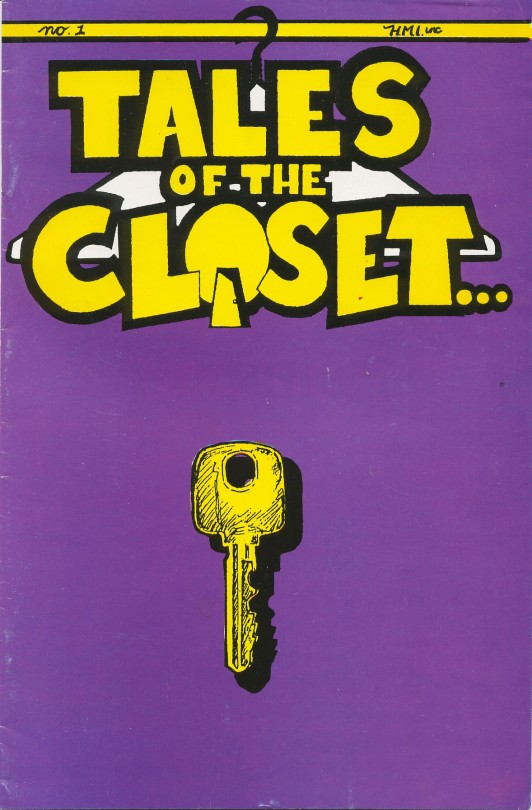
Tales Of The Closet #1 (1987-1993) by Ivan Velez Jr. Published by the Hetrick-Martin Institute, a non profit LGBT youth outreach program in New York City, Tales Of The Closet tells the story of eight very different LGBT high school students who meet in a Queens high school in the mid-80's. Dealing with the specific complications of growing up LGBT in that time period and the melodramatic complications of being characters in a comic book, it is educational yet never sacrifices in the storytelling. While only intended to be ten issues, only nine were produced. According to a post on creator Ivan Velez Jr's Instagram, issue #10 will drop in November 30, 2024.
#classic#style#gay#art#gay artist#gay art#gay comics#tales of the closet#gay history#lgbt history#lgbt pride#lgbt books
40 notes
·
View notes
Note
African/African-American/Black
Do The Right Thing (1989) On the hottest day of the year on a street in the Bedford-Stuyvesant section of Brooklyn, everyone's hate and bigotry smolders and builds until it explodes into violence.
Goodbye Solo (2008) This film is touching and humorous. It is the story of an unlikely friendship between a struggling but happy cab driver from Senegal, and a tormented southern man with secrets.
Lincoln (2012) As the Civil War continues to rage, President struggles with continued fighting on the battlefield during the civil war but he also fights with many inside his own cabinet with his decision to emancipate the slaves.
Malcom X (1992) Biographical epic of the controversial and influential Black Nationalist leader, from his early life and career as a small-time gangster to his ministry as a member of the Nation of Islam.
Straight Outta Compton (2015) The group NWA emerges from the mean streets of Compton in Los Angeles, California, in the mid-1980s and revolutionizes Hip Hop culture with their music and tales about life in the hood.
The Color of Friendship (2000) Mahree Bok is a white South African teenager and a product of the Apartheid system raised to view dark-skinned people as second-class citizens. Piper Dellums is the daughter of an African-American U.S. Congressman living in Washington D.C. When Mahree is chosen to spend her time as an exchange student at the Dellums's house, she is shocked on her arrival to discover that the Dellums are black, and the Dellums are just as surprised when they realize that Mahree is a white South African.
The Color Purple (1985) Based on Alice Walker's Pulitzer Prize-winning novel, The Color Purple is a richly-textured, powerful film set in America's rural south. It is a brilliant drama about a black woman's struggles to take control of her life in a small Southern town in the early 20th century.
The Help (2011) This academy award winning movie takes place during the civil rights movements of the 1960’s, when an aspiring writer decides to write a book about the African-American maids' point of view on the white families they work for and the hardships they experience on a daily basis.
——————————————
Cambodian/Chinese/Vietnamese
Eat Drink Man Woman (1994) A senior chef lives with his three grown daughters; the middle one finds her future plans affected by unexpected events and the life changes of the other household members.
Holly (2006) In Cambodia, Holly, a 12-year-old Vietnamese girl, encounters Patrick, an American stolen artifacts dealer. The story follows their strong connection and her unrelenting efforts to escape her fate.
Last Train Home (2009) A couple embarks on a journey home for Chinese new year along with 130 million other migrant workers, to reunite with their children and struggle for a future. Their unseen story plays out as China soars towards being a world superpower.
Lost in Paradise (2011) Khoi, naive twenty-year-old travels to Ho Chi Minh City from the countryside to begin a new life. It's his first time in the big city and he's looking for a place to live.
Raise the Red Lantern (1991) A young woman becomes the fourth wife of a wealthy lord and must learn to live with the strict rules and tensions within the household.
Sentenced Home (2007) This documentary follows three Cambodian-American men, brought to the U.S. as children by their refugee families. They were raised in the grim public housing of Seattle, among gangs and other realities of that life. Bad choices as teens altered their lives forever, when immigration laws after 9/11 provided no second changes for such children. Though they were raised in the U.S., speak to one another in English, even think in English, each is sentenced to return to Cambodia - separated from family here, possibly forever.
The Joy Luck Club (1993) The story of four Chinese women who immigrated to the U.S. and their first-generation daughters. When one of the women dies, her daughter plays Mahjong with the older women and begins to really learn what her mother endured in China and of her sisters who were left behind. Daughter from Danang (2002) Separated at the end of the Vietnam war, an "Americanized" woman and her Vietnamese mother are reunited after 22 years.
The Last Emperor (1987) The story of the final Emperor of China.
The Quiet American (2002) An older British reporter vies with a young U.S. doctor for the affections of a beautiful Vietnamese woman.
The Vertical Ray of the Sun (2000) The plot centres around three sisters, two of whom are happily married (or so it appears).
Three Seasons (1999) An American in Ho Chi Minh City looks for a daughter he fathered during the war. He meets Woody, a child who's a street vendor, and when Woody's case of wares disappears, he thinks the soldier took it. Woody hunts for him.
——————————————
South Asian/Indian
Bhaji on the Beach (1998) Hashida, an 18-year old Asian woman, lives with her family in Birmingham. Her father wants her to become a doctor and next month her medical school is going to start. Secretly, she has a black boyfriend – which is an absolute faux pas in some Asian cultures – and has now discovered that she is pregnant. She joins a small South Asian women's group on a trip to Blackpool, a trip that holds life-changing experiences for all.
Bend It Like Beckham (2002) Teen-aged Londoner Jesminder Bhamra chases her dream of being a professional soccer player while dealing with the objections of her traditional Sikh family.
Gandhi (1982) A biography of Mohandas K. Gandhi, the lawyer who became the famed leader of the Indian revolts against the British rule through his philosophy of non-violent protest.
Slum Dog Millionaire (2008) A teen in Mumbai, India who grew up in the slums, becomes a contestant on the Indian version of "Who Wants To Be A Millionaire?" When he is suspected of cheating, he is arrested. During his police interrogation, events from his life history are shown which explain why he knows the answers.
The Namesake (2006) A tale of a first-generation son of traditional, Indian immigrant parents. As he tries to make a place for himself, not always able to straddle two worlds gracefully, he is surprised by what he learns about his family and himself.
——————————————
Disease/Mental Illness/Disability
My Left Foot: The Story of Christy Brown (1989) Christy Brown, born with cerebral palsy, learns to paint and write with his only controllable limb - his left foot.
The Theory of Everything (2014) A look at the relationship between the famous physicist Stephen Hawking and his wife.
Ray (2004) The story of the life and career of the legendary rhythm and blues musician Ray Charles, from his humble beginnings in the South, where he went blind at age seven, to his meteoric rise to stardom during the 1950s and 1960s.
Silver Linings Playbook (2012) After a stint in a mental institution, former teacher Pat Solitano moves back in with his parents and tries to reconcile with his ex-wife. Things get more challenging when Pat meets Tiffany, a mysterious girl with problems of her own.
Still Alice (2014) A linguistics professor and her family find their bonds tested when she is diagnosed with Alzheimer's Disease.
——————————————
LGBTQ+
A Single Man (2009) The story of an English professor, who one year after the sudden death of his boyfriend, is unable to cope with his typical days in 1960s Los Angeles. It is a powerful story of his grief and pain for the loss of someone he truly deeply loved.
Boys Don’t Cry(1999) This film is about the true life story of Brandon Teena, a young woman who is going through a sexual identity crisis. She cuts her hair and dresses like a man to see if she can pass as one. She lived life in a male identity until it was discovered he was born biologically female.
Brokeback Mountain (2005) This film tells the story of a forbidden and secretive relationship between two same-sex cowboys and their lives over the years.
Milk (2008) This film tells the story of American gay activist, Harvey Milk, and his struggles as he fights for gay rights and becomes California's first openly gay elected official.
Philadelphia (1993) In this movie, a lawyer, working for a conservative law firm, is diagnosed with AIDS. His employer fires him because of his condition. He tries to find someone to take his case but all refuse except one willing small time lawyer who advocates for a wrongful dismissal suit in spite of his own fears and homophobia.
The Danish Girl (2015) A fictitious love story loosely inspired by the lives of Danish artists Lili Elbe and Gerda Wegener. Lili and Gerda's marriage and work evolve as they navigate Lili's groundbreaking journey as a transgender pioneer.
Transamerica (2005) A pre-operative male-to-female transgender takes an unexpected journey when she learns that she fathered a son, now a teenage runaway hustling on the streets of New York.
——————————————
Hispanic/Latino(a)/Mexican
A Day Without a Mexican (2004) One-third of the population of California is Latinos, Hispanics, Mexicans. How would it change life for the state's other residents if this portion of the populous suddenly vanished? The film is a "mockumentary" designed to show the valuable contributions made every day by Latinos.
Babel (2006) Tragedy strikes a married couple on vacation in the Moroccan desert, touching off an interlocking story involving four different families.
El Norte (1983) The Guatemalan army discovers Mayan Indian peasants who have begun to organize, hoping to rise above their label of "brazos fuertes" or "strong arms" (manual laborers). The army massacres their families and destroys their village to give the new recruits no choice but to follow and obey. However, two teenage siblings survive and are determined to escape to the U.S. or El Norte. They make their way to L.A. - uneducated, illegal immigrants, alone.
Mi Familia (My Family) (1995) This epic film traces over three generations an immigrant family's trials, tribulations, tragedies, and triumphs. Jose and Maria, the first generation, come to Los Angeles, meet, marry, face deportation all in the 1930s. They establish their family in East L.A., and their children Chucho, Paco, Memo, Irene, Toni, and Jimmy deal with youth culture and the L.A. police in the 1950s. As the second generation become adults in the 1960s, the focus shifts to Jimmy, his marriage to Isabel (a Salvadorian refugee), their son, and Jimmy's journey to becoming a responsible parent.
Sin Nombre (2009) A Honduran young girl and a Mexican gangster are united in a journey across the American border.
Under the Same Moon (2007) Heartwarming story about a mother who leaves Mexico to make a home for herself and her son (Adrian Alonso). When the boy's grandmother dies, leaving him alone, he sets off on his own to find his mother.
——————————————
Immigrants/Undocumented
Crossing Arizona (2006) With Americans on all sides of the issue up in arms and Congress in a policy battle over how to move forward, Crossing Arizona tells the story of how we got to where we are today. Heightened security in California and Texas has pushed illegal border-crossers into the Arizona desert in unprecedented numbers (estimated 4,500 a day). Most are Mexican men in search of work, but increasingly the border-crossers are women and children wanting to join their husbands and fathers. This influx of migrants crossing through Arizona and the attendant rising death toll has elicited complicated feelings about human rights, culture, class, labor, and national security.
Dancer in the Dark (2000) An east European girl goes to America with her young son, expecting it to be like a Hollywood film.
El Norte (1983) The Guatemalan army discovers Mayan Indian peasants who have begun to organize, hoping to rise above their label of "brazos fuertes" or "strong arms" (manual laborers). The army massacres their families and destroys their village to give the new recruits no choice but to follow and obey. However, two teenage siblings survive and are determined to escape to the U.S. or El Norte. They make their way to L.A. - uneducated, illegal immigrants, alone.
In America (2002) A family of Irish immigrants adjusts to life on the mean streets of Hell's Kitchen while also grieving the death of a child.
The Terminal (2004) When an Eastern European immigrant comes to American to fulfill a promise to his father he finds himself stranded inside JFK airport, making it his temporary residence when he cannot enter the USA nor return home.
The Visitor (2007) A lonely economics professor in Connecticut life is changed forever - and for the better - when he finds a couple of illegals, who happen to be living in his New York apartment.
Green Card (1990) A French man wanting to stay in the US enters into a “short-term” marriage to an American woman so he can get his green card. Complications result when he gets caught lying.
——————————————
Indigenous
Avatar (2009) A paraplegic marine dispatched to the moon Pandora on a unique mission becomes torn between following his orders and protecting the world he feels is his home.
Bury My Heart at Wounded Knee (2007) A chronicle of how American Indians were displaced as the U.S. expanded west. Based on the book by Dee Brown.
Once Were Warriors (1994) A family descended from Maori warriors is bedeviled by a violent father and the societal problems of being treated as outcasts.
Rabbit-Proof Fence (2002) In 1931 Australia, government policy includes taking half-caste children from their Aboriginal mothers and sending them a thousand miles away "to save them from themselves." Molly, Daisy, and Grace (two sisters and a cousin who are 14, 10, and 8) arrive at their “school” and promptly escape, under Molly's lead. For days they walk north, following a fence that keeps rabbits from settlements, eluding a native tracker and the regional constabulary. Their pursuers take orders from the government's "chief protector of Aborigines," A.O. Neville, blinded by Anglo-Christian certainty, evolutionary worldview and conventional wisdom.
Smoke Signals (1998) Young Indian man Thomas is a nerd in his reservation, wearing oversize glasses and telling everyone stories no-one wants to hear. His parents died in a fire in 1976, and Thomas was saved by Arnold. Arnold soon left his family (and his tough son Victor), and Victor hasn't seen his father for 10 years. When Victor hears Arnold has died, Thomas offers him funding for the trip to get Arnold's remains, but only if Thomas will also go with him. Thomas and Victor hit the road.
The Spirit of Crazy Horse (1990) One hundred years after the massacre at Wounded Knee, Milo Yellow Hair recounts the story of his people-from the lost battles for their land against the invading whites-to the bitter internal divisions and radicalization of the 1970's-to the present-day revival of Sioux cultural pride, which has become a unifying force as the Sioux try to define themselves and their future.
Whale Rider (2002) On the east coast of New Zealand, the Whangara people believe their History dates back a thousand years to a single ancestor, Paikea, who escaped death when his canoe capsized by riding to shore on the back of a whale. Whangara chiefs have been considered Paikea's direct descendants. Pai, an 11-year-old girl in a patriarchal New Zealand culture, believes she is destined to be the new chief. But her grandfather Koro is bound by tradition to pick a male leader. Pai must fight a thousand years of tradition to fulfill her destiny.
——————————————
Middle Eastern
Baran (2001) In a building site in present-day Tehran, Lateef, a 17-year-old Turkish worker is irresistibly drawn to Rahmat, a young Afghan worker. The revelation of Rahmat's secret changes both their lives.
Incendies (2010) Twins journey to the Middle East to discover their family history, and fulfill their mother's last wishes.
Schindler's List (1993) In German-occupied Poland during World War II, Oskar Schindler gradually becomes concerned for his Jewish workforce after witnessing their persecution by the Nazi Germans.
The Band’s Visit (2007) A band comprised of members of the Egyptian police force head to Israel to play at the inaugural ceremony of an Arab arts center, only to find themselves lost in the wrong town.
Turtles Can Fly (2004) Near the Iraqi-Turkish border on the eve of an American invasion, refugee children like 13-year-old Kak (Ebrahim), gauge and await their fate.
Wadjda (2012) An enterprising Saudi girl signs on for her school's Koran recitation competition as a way to raise the remaining funds she needs in order to buy the green bicycle that has captured her interest.
——————————————
Pacific Islander/Polynesian
Balangiga: The Howling Wilderness (2017) 1901, Balangiga. Eight-year-old Kulas flees town with his grandfather and their carabao to escape General Smith's Kill and Burn order. He finds a toddler amid a sea of corpses and together, the two boys struggle to survive the American occupation.
Moana (2016) In Ancient Polynesia, when a terrible curse incurred by the Demigod Maui reaches an impetuous Chieftain's daughter's island, she answers the Ocean's call to seek out the Demigod to set things right.
Once Were Warriors (1994) A family descended from Maori warriors is bedeviled by a violent father and the societal problems of being treated as outcasts.
Princess Kaiulani (2009) The story of a Hawaiian princess' attempts to maintain the independence of the island against the threat of American colonization.
Whale Rider (2002) On the east coast of New Zealand, the Whangara people believe their History dates back a thousand years to a single ancestor, Paikea, who escaped death when his canoe capsized by riding to shore on the back of a whale. Whangara chiefs have been considered Paikea's direct descendants. Pai, an 11-year-old girl in a patriarchal New Zealand culture, believes she is destined to be the new chief. But her grandfather Koro is bound by tradition to pick a male leader. Pai must fight a thousand years of tradition to fulfill her destiny.
——————————————
Women
Āfsāīd = Offside (2006) Struggle of Women in a country that excludes them from entering the stadiums.
The Help (2011) This academy award winning movie takes place during the civil rights movements of the 1960’s when an aspiring writer decides to write a book about the African-American maids' point of view on the white families they work for and the hardships they experience on a daily basis.
Suffragette (2015) The foot soldiers of the early feminist movement, women who were forced underground to pursue a dangerous game of cat and mouse with an increasingly brutal State.
Water (2005) The film examines the plight of a group of widows forced into poverty at a temple in the holy city of Varanasi. It focuses on a relationship between one of the widows, who wants to escape the social restrictions imposed on widows, and a man who is from the highest caste and a follower of Mahatma Gandhi.
Whale Rider (2002) On the east coast of New Zealand, the Whangara people believe their History dates back a thousand years to a single ancestor, Paikea, who escaped death when his canoe capsized by riding to shore on the back of a whale. Whangara chiefs have been considered Paikea's direct descendants. Pai, an 11-year-old girl in a patriarchal New Zealand culture, believes she is destined to be the new chief. But her grandfather Koro is bound by tradition to pick a male leader. Pai must fight a thousand years of tradition to fulfill her destiny.
Ooh amazing, thank you for this! ❤️
I've watched Slumdog Millionaire, Brokeback Mountain, and Schindler's List. And read a Penguin Classics abridged version of Rabbit-Proof Fence as part of my English learning back in my teenage years. Some of the others I'm familiar with tho have yet to watch; and others are completely new to me
35 notes
·
View notes
Text
Another list of Thomas's Early Work + links
♡Compiled playlist of full movies + soap/tv episodes featuring thomas♡
Playlist✨ (youtube)
Original List✨ (ones not linked here)
Photos and list below is what's featured in the playlist. *besides "sleep with me" which can links to the movie archive.


The Guiding Light (1987) **Major TW for this scene**
Leg Work (1987)
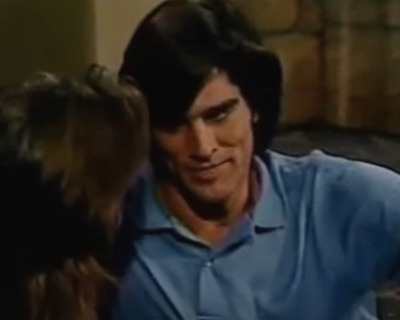
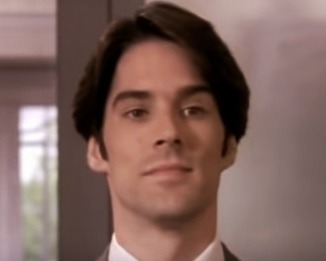
As The World Turns (1989) *15 episodes in playlist*
Tales of The City (1993) *pretty sure i compiled 90% of the episodes*
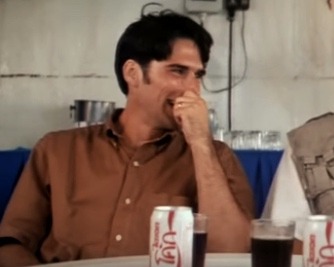

Men of War (1994)
To Love, Honour and Deceive (1996)


The Inheritance (1997)
Brush With Fate (2003)
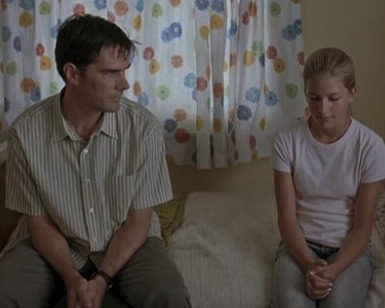
Come Away Home (2005)

Sleep With Me (1994) Can be watched in HQ here.
*11/23 update: barcelona removed
#criminal minds#thomas gibson#thomas gibson scene#thomas gibson edit#young thomas gibson#ssa aaron hotchner#aaron hotchner#aaron hotch hotchner#aaron hotch x reader#hotch#hotch x y/n#hotch x reader#hotch x you#aaron hotchner x y/n#aaron hotchner x you#aaron hotchner x reader#criminal minds au#criminal minds edit#behavioral analysis unit#aaron hotchner x female reader#dad hotch#bau#aaron hotchner fanfiction#aaron hotchner smut#hotch smut#hotchner smut#hotch imagine#aaron hotchner fluff#ssa hotchner#criminal minds screencap
102 notes
·
View notes
Text
all landlords are scum except Mrs. Madrigal
#she's a treasure and i would protect her with my life#(why yes i am sick as hell and rewatching Tales of the City 1993 why do you ask)
4 notes
·
View notes
Text
Dragon Ball Super Movie 1: Broly (2/3)
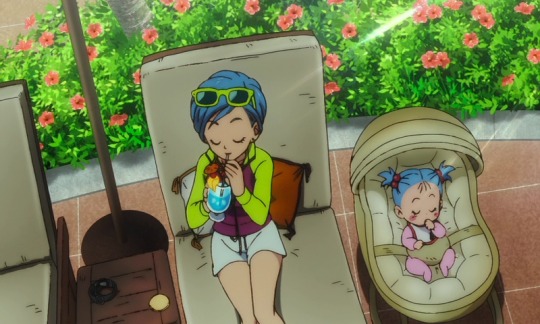
Well, enough of that flashback stuff. Let's move on to the present.
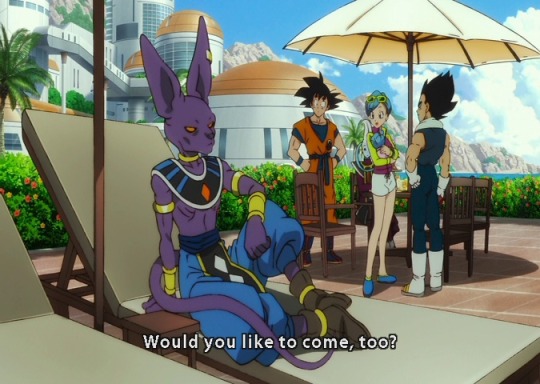
So after the destruction of Planet Vegeta, uh all of Dragon Ball, Dragon Ball Z, and Dragon Ball Super happened. This is kind of a weak point for this movie, because it's story is rooted in Goku's origin tale, but the climax takes place when Goku's a middle-aged man, so a lot of lore has happened in between. There's a similar thing going on when Raditz and Frieza show up in DBZ, and when Broly made his debut in the 1993 film, but Goku was 24-30 in those stories, so it wasn't quite as big a strain.
The thing is, the stuff we had to skip over was extremely important, and the movie simply can't go over all of it. If someone who knew nothing about Dragon Ball watched this thing, they would probably think that this is a story about Goku and Vegeta trying to avenge their people by defeating Frieza, except that already got dealt with in 1991. Goku, Vegeta, and Frieza have each been killed and resurrected... twice. This movie doesn't have time to explain all their baggage, much less how Goku and Vegeta became pals. So no one even tries to fill in the audience on who this big purple cat man is. You either saw Battle of Gods or you just have to roll with it.
And you know what? Good. No one was there to explain Ox King or Mr. Popo to me when I first got into this thing. I've been watching this stuff for a quarter century, and I still don't know what the fuck Tien's third eye is all about. Context is for the weak.
Anyway, this scene takes place on a private island Bulma bought some time ago. She had a resort built here so Goku and Vegeta could spar without damaging West City. And the food is good, so Beerus and Whis tagged along, although neither of them really have any impact on the plot at all. Whis asks Goku why he wants to get stronger, and Goku explains that he's feeling inspired after the recent Tournament of Power arc from the tail end of the DBS anime. Vegeta, on the other hand, is only concerned with Frieza, who was restored to life during that storyline. Frieza's more powerful than ever before, and Vegeta expects him to get even stronger and menace the Earth again.
Sure enough, Bulma gets a call from Trunks as Capsule Corp, who informs them that Bulma's collection of Dragon Balls and the Dragon Radar have been stolen by goons wearing Frieza Force uniforms. But the joke's on them, because Bulma only had six of the Dragon Balls collected. The seventh is on the Ice Continent, so they know exactly where to go to intercept the thieves. Beerus doesn't want to tag along for the trip, so Bulma leaves her infant daughter Bulla with Beerus.
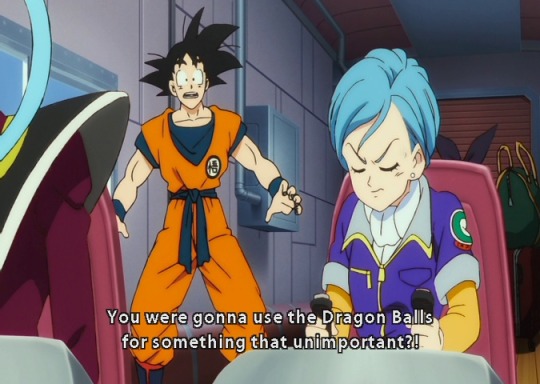
So what was Bulma planning to wish for? She admits that she was going to ask Shenron to make her look five years younger. Why only five? Because if she got too young all at once, people would think she had work done.

So what does Frieza plan to wish for? Immortality was what he wanted on Namek, but not this time. No he only wants to grow about five centimeters taller. Why not just use his second or third forms to be tall? Because he wants to be taller in any of his forms. Why only five centimeters? Because he wants it to seem like he's still growing.
I've never been too happy about this gag. I mean, it's a good gag, but I liked it better the first time, when Commander Red planned to use the Dragon Balls to make himself taller. It does add some complexity to Frieza's character, though, since he's not just stubbornly trying the exact same routine that got him wrecked on Namek, and then killed on Earth, and then re-killed on Earth again.
This time, he's not trying to take the Dragon Balls by force, because he knows Goku and Vegeta are too powerful to challenge head-on. So he's using stealth instead. The minions he sent to Earth are weaker guys, which mean Goku and Vegeta wouldn't sense their ki. And it seems like Frieza's plan is to just sneak down to Earth, make the wish, and head out before anyone can stop them.
And he's not pursuing the same wish he had twenty-odd years ago. Really, Frieza was never that interested in immortality in the first place. He only decided to wish for that because it was the one thing he didn't already have. But now he's been dead twice over, and that's given him a new perspective on life and death, and he seems to think being unable to die would be similar to the unending torment he experienced in hell. Neither does he seek an invincible body. I'm not sure Shenron could give him greater strength, but Frieza feels that would take all the fun out of "the game". If nothing else, it's interesting to see Frieza consider this at all. Back in the Namek Saga, he never thought about wishing for greater power, because he believed he already was the strongest in the universe. Now that he knows otherwise, he seems fairly content with that.
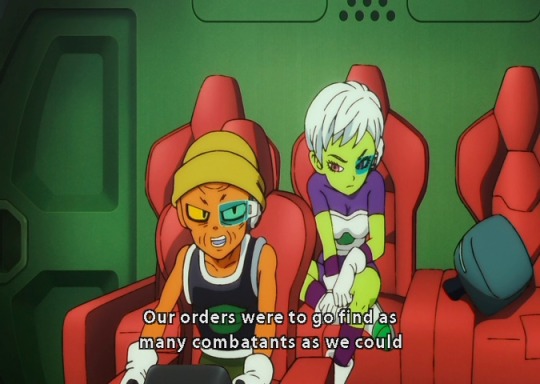
Meanwhile, we meet the last two players in this drama, Leemo and Cheelai. They're operatives in the Frieza Force, but they're not warriors. Leemo's been with the Frieza Force from the beginning, and Cheelai's a recent recruit, having joined up to avoid the consequences of stealing a Galactic Patrol ship. Their orders are to find more warriors to join the Frieza Force, since their ranks are pretty threadbare. Remember, when Frieza destroyed the Saiyans, they made up half of his fighting force. The other half was still quite formidable, but all of his best troops ended up getting killed during Frieza's disastrous invasion of Namek. Then Frieza came back and tried to attach Earth in Resurrection F, and he brought like a thousand soldiers with him, and those guys all got killed as well.
As Cheelai observes, Frieza is down to women and old men like herself and Leemo. There just aren't many warriors available in the universe these days, because all the good talent got killed off a long time ago. As they discuss this, Leemo picks up a distress signal from Planet Vampa. Thinking their might be a reward for it, they head over to answer the call, and find...
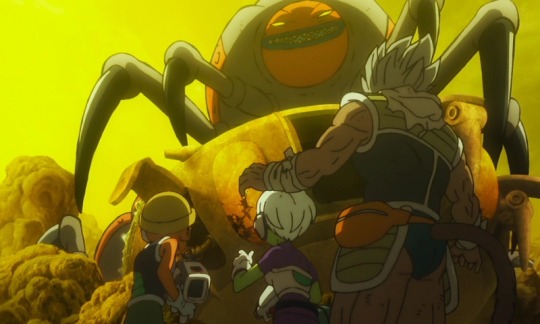
Paragus! Also a bunch of alien monsters. Fortunately, Paragus isn't alone...
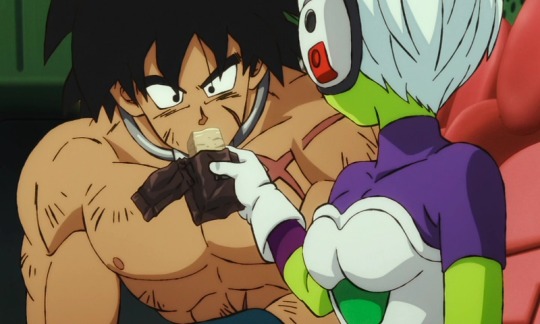
They also find Broly on Vampa, and he's all grown up and stronger than ever. Their scouters measure Paragus' power level at 4200, which isn't too impressive these days, but it's way better than anything the Frieza Force has at the moment. And Broly's power is too high for the scouters to measure, so they definitely want him to come along. On the way to Frieza's ship, Cheelai feeds Broly rations and takes a liking to the big guy.
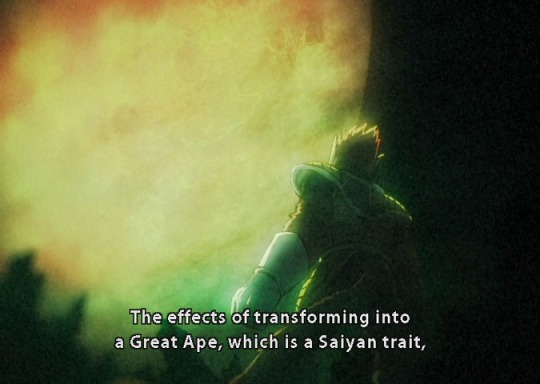
When the four of them report to Frieza, Paragus explains that he had to cut off Broly's tail because of the frequent full moons on Vampa, which cause Broly to lose control of himself as a giant ape. Occasionally, Broly still loses control of himself anyway, but Paragus can rein him in using...
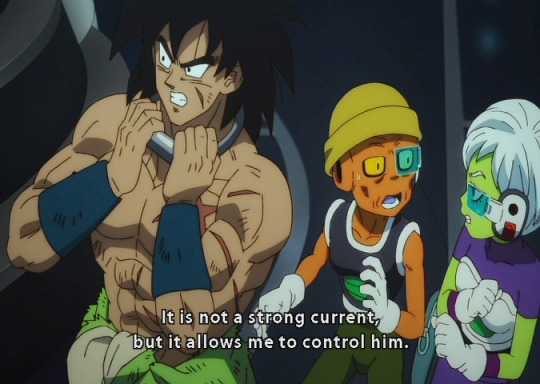
... a shock collar, which he can activate with a remote control. Leemo and Cheelai are horrified to learn of this, but not so horrified that they turn down the generous reward Frieza gives them for their discovery.
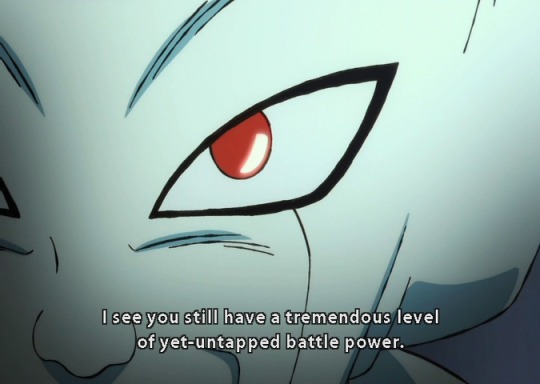
Now, one thing that always bugged me about this movie is that Frieza immediately starts making plans to use Broly against Goku and Vegeta. He wasn't planning to attack them this time around, but now that he has Broly on his team, it seems much more favorable. Later, when the fighting starts, Frieza is disappointed to find that Broly can't transform into a Super Saiyan, but why would he expect Broly to be able to do any of that? Sure he's a Saiyan, but Goku and Vegeta have mastered power levels far, far beyond what other Saiyans have ever dreamed possible.
But I keep forgetting that Frieza can sense ki these days, the same way Goku can. Back in the Namek Saga, Frieza had to rely on scouters like the rest of his goons, but when he trained to become Golden Frieza in Res F, he learned to sense energy. So when he sizes up Broly, he's not just guessing at how strong this guy is. He can actually perceive the untapped potential in Broly's body, and he seems to recognize that Broly would be capable of giving Goku and Vegeta a hard time. So it makes sense.
Anyway, Paragus is happy to cooperate, since he still despises King Vegeta for what happened, and he's down to attack Prince Vegeta to even the score. And Broly has to do whatever Paragus wants or he gets another shock.

Later, Cheelai tries to get to know Broly better, but Paragus forbids Broly from speaking. While they argue over this, another henchman tries to drunkenly hit on Cheelai. I really like how Leemo tries to defuse the situation here. He's not a fighter, so it suits his character that he'd try to employ a nonviolent solution, like offering to buy this guy a drink. Being a noncombatant in the Frieza Force, he's probably grown accustomed to swimming with the sharks like this. But it doesn't work, and then Broly steps up to use a non-nonviolent solution, which is violence.
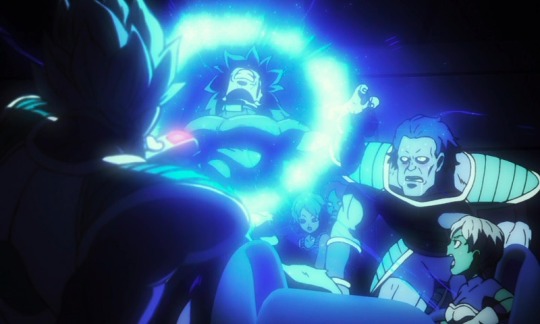
But Paragus doesn't want to offend his host, so he gives Broly another shock. Cheelai confronts him over this, and while she chews him out, she swipes his remote control. Then Paragus gets summoned to talk with Frieza. While he's gone, Cheelai destroys the remote, and they listen to Broly tell the story of his green fur wrap.
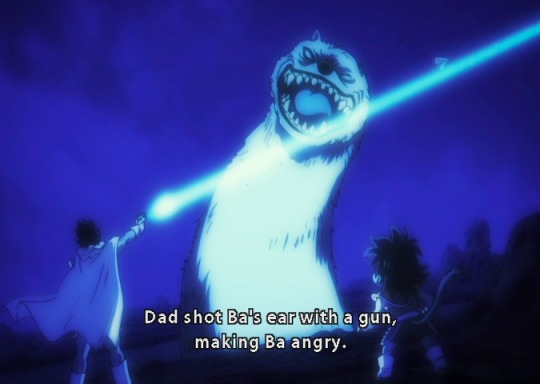
It's a pretty simple story. The closest thing Broly had to a friend on Vampa was one of the large green creatures on the planet. Paragus used the creature to train Broly, goading it to attack, and then having Broly dodge it. But over time, the creature became accustomed to Broly, and they became pals. But Paragus wanted the creature to be hostile, so he shot its ear off with a laser pistol to piss it off. Ever since, Broly has kept the ear and wears it as a memento of their friendship.
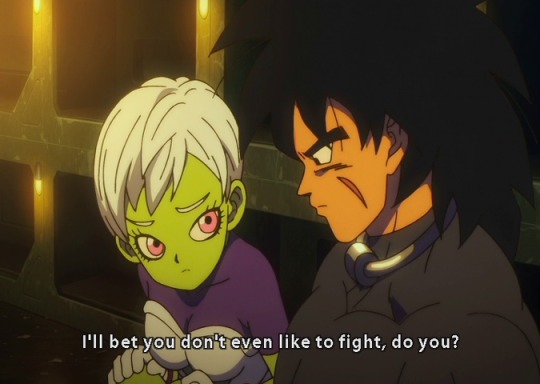
I like how easily Cheelai and Leemo sympathize with Broly in this movie. They're not good guys at all. Cheelai's an opportunistic thief, and Leemo's a cog in Frieza's evil empire. But they're not heartless, and Broly's story is so tragic and innocent that you can't help but feel for the guy. Leemo compares Paragus to his own rotten father, so you can tell that he can relate to what Broly is going through. And Cheelai can tell when someone's being used. Paragus can dress it up all he likes, but he's just using Broly's power to serve his own selfish interests.
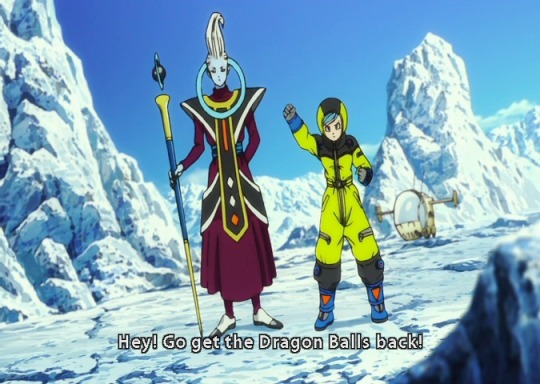
Moving on, Frieza's team on Earth have located the seventh Dragon Ball, and Frieza's fleet moves in to join them for the wish-making. But Bulma, Goku, and Vegeta get their first. They probably would have arrived sooner, but Bulma wanted to stop somewhere to buy cold-weather gear. Let's just take a moment to admire her safety-yellow snowsuit. She looks like a baby duck in this thing and it's great.

Frieza confronts Goku and Vegeta and introduces Paragus and Broly. I never really noticed these guardsmen who stand by while Frieza steps out of the ship. Paragus should have gotten one of those uniforms, since that pink shower curtain he's wearing looks dumb as hell.
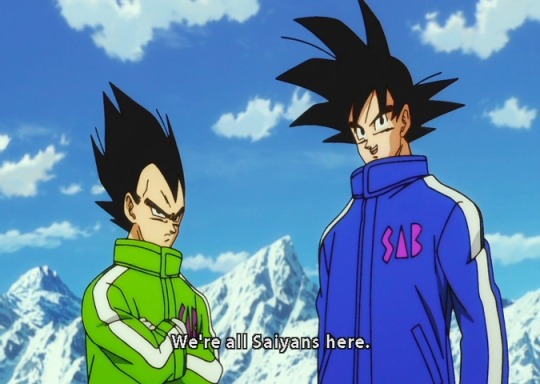
I mean, look at Goku. Bulma got him a sweet blue coat and he looks like a million bucks. He tries to convince Paragus and Broly to get along as fellow Saiyans, but that doesn't get him anywhere. You'd think he'd know better by now.
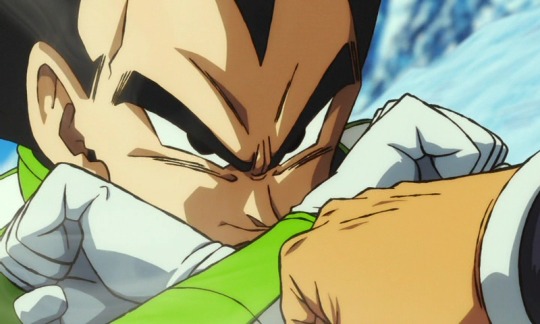
So Broly's rarin' to go, and Frieza sees no reason to make him wait, and it's on. Broly attacks Vegeta, and that brings us to the final leg of this movie, which we'll cover next time.
#dragon ball#2023dbapocryphaliveblog#dragon ball super#dragon ball super: broly#broly#goku#vegeta#frieza#paragus#cheelai#leemo#bulma#whis#beerus#bulla
109 notes
·
View notes
Text
A compendium of references to Portugal in Japanese video games
The beginning of the historical relations between Portugal and Japan dates to the year 1541, when a Portuguese ship washed ashore at Jingujiura. Nearly sixty Japanese words are of Portuguese origin. A variety of Japanese traditions and culinary delights were introduced by Portuguese traders, sailors and missionaries. But in what way has this cultural exchange extended to the more recent phenomenon of Japanese digital games? As a portuguese devotee of Japanese culture, the topic seemed relevant enough to merit some additional exploration.
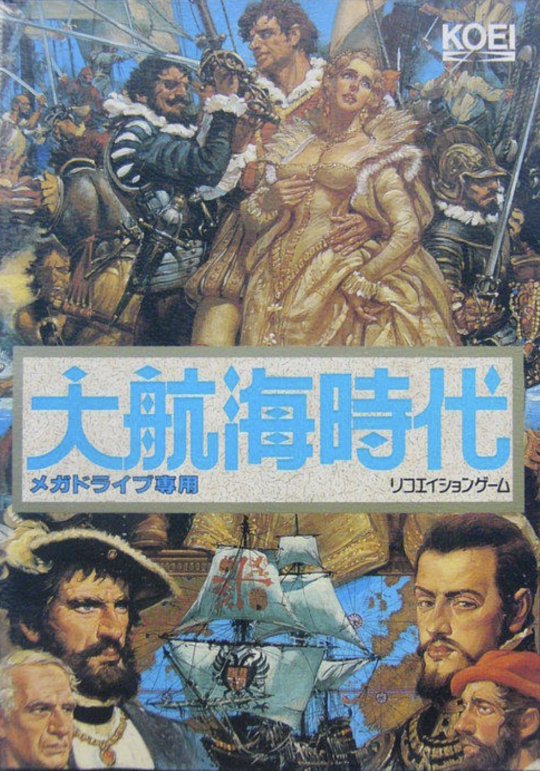

To my knowledge, the first significant reference to Portugal in Japanese video game is found in Koei's The Age of Discovery from 1990, a game published in the west under the title Uncharted Waters. The main character is a disgraced Portuguese nobleman named Leon Ferrero who resorts to maritime exploration, trade and naval warfare to restore his family's good name and prestige.

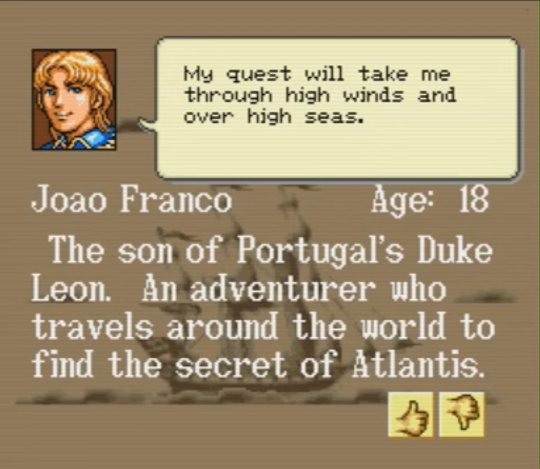
Its 1993 sequel, known in the west as New Horizons, diversifies the base game structure of the original by including multiple characters to select from, each with their own story and mission. Among them is the tale of João Franco, the son of the original episode's protagonist Leon, who sets out to discover the mysterious location of the fabled Atlantis, no less.
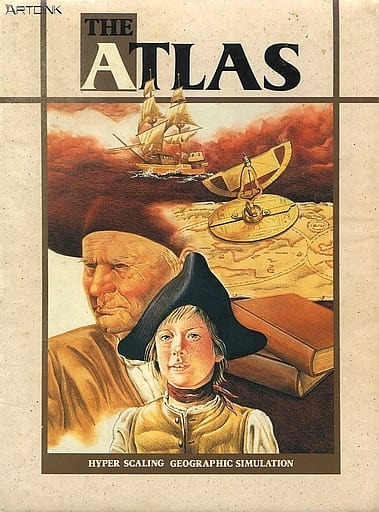
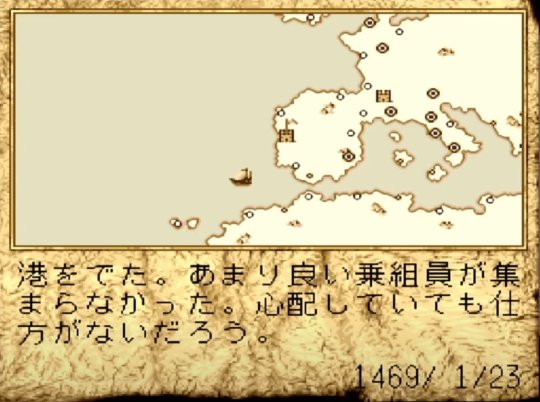
Another meaningful reference can be found a year later in ArtDink's 1991 strategy game The Atlas, in which the player takes on the role of a 15th century explorer with a five year contract with the King of Portugal to discover and chart lands around the Iberian Peninsula.
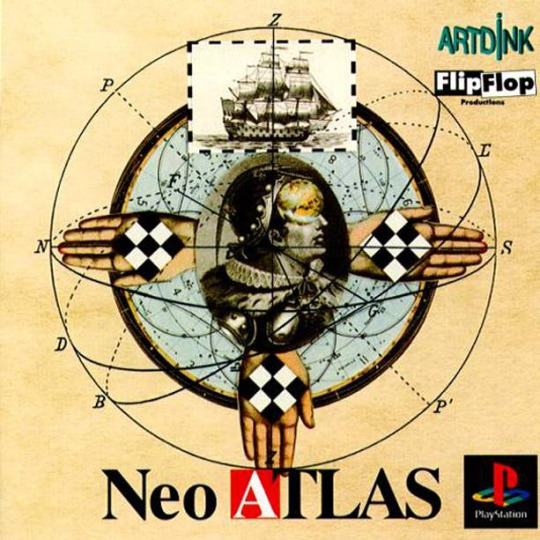
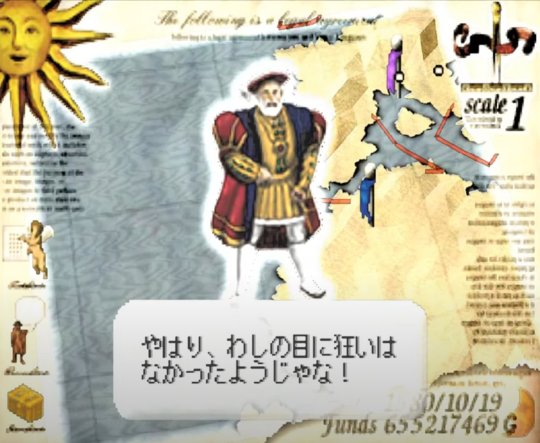
In 1998, ArtDink recreated the game for contemporary systems and published as Neo Atlas. The protagonist is a Portuguese trading company owner seeking business expansion opportunities in remote territories, as well as discover and chart hitherto unknown parts of the globe. A similar premise is found in a later sequel, Neo Atlas III.
Apart from nautical strategy games, a few other titles exist where mentions to the Portuguese territory, language and culture can be traced.
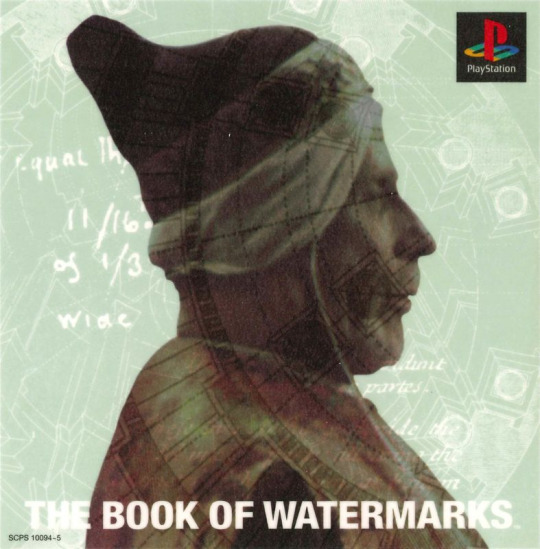
Galvanized by the success of Cyan's world-renowned point and click adventure CD-ROMs, Sony Computer Entertainment helped to publish The Book of Watermarks, a game designed by a miniscule Tokyo-based studio named Watermarks that is brimming with interesting first and second-hand references to Shakespeare's The Tempest. The objective of this visually impressive pre-rendered journey is to aid in the recovery of a series of ancient tomes, each including the nuclear bases of knowledge for mankind.
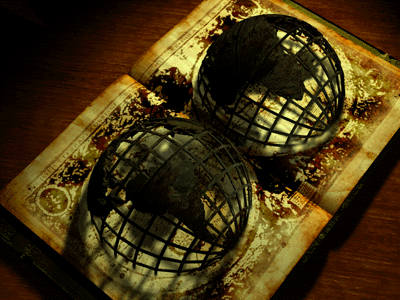
The very first lost volume is named the Book of Navigators, said to be owned by the historical Infante Dom Henrique from the 15th century, condensing information on shipbuilding, oceanography, geography and astronomy. While a purely fictitious book, the reference to Prince Henry is historically accurate, him being a pivotal figure in the early age of Portuguese maritime discoveries, the governor of the Order of Christ who at once built and ruined his reputation through his various campaigns in the African continent.
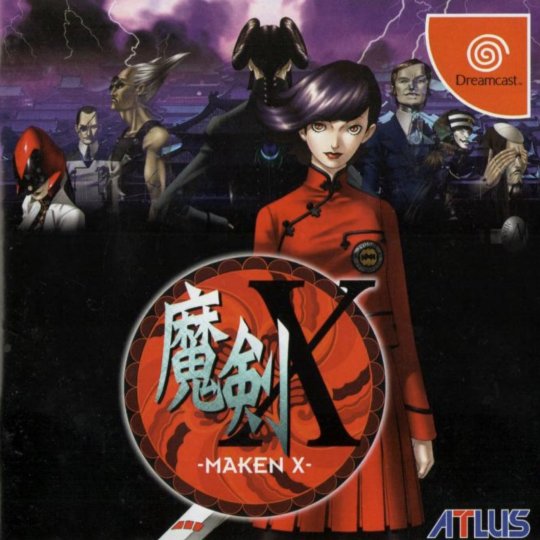
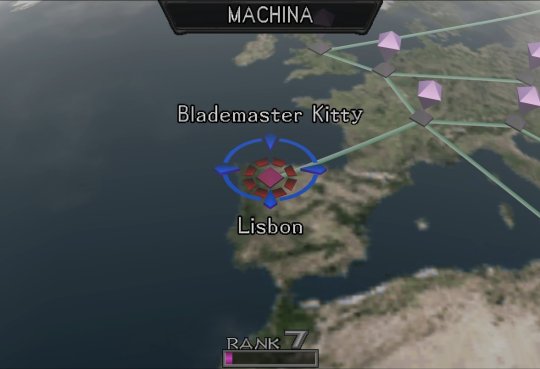

Atlus' futuristic vision of Earth in Maken X includes a most unexpected tour of Europe, with a mandatory stop in Lisbon. Inexplicably, the developers got its geographic location wrong and moved to all the way to the northern Spanish region of Léon. The level, itself, boasts a reasonably accurate depiction of one of the city's oldest quarters, Alfama, and the architectural styles found therein.


Although I could not discern any actual references in the game itself, the Grandia II soundtrack by the veteran composer Noriyuki Iwadare contains two themes whose lyrics are written in Portuguese: A Deus, a double-entendre that can be translated to both farewell and to God; and Canção do Povo, meaning People's Song. Also, the name of the official soundtrack is named Melodia, which translates to Melody as you'd expect. Both themes were performed by guest singer Kaori Kawasumi, who took on the composer's challenge to sing them despite her not knowing the language.
She was coached and assisted by José Álvarez and Motoi Sato from the Portuguese Arts and Culture Center in Japan, whom she thanks in the acknowledgement section. The Grandia II Special Package edition booklet contains a page with two photos of Portugal, one for the Jéronimos Monastery in Lisbon and the other, seemingly, for the Moorish Castle in the nearby town of Sintra.
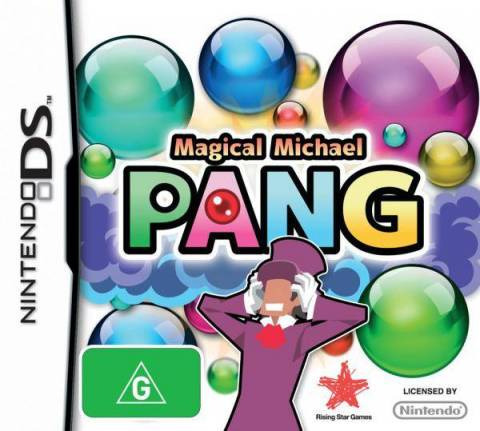
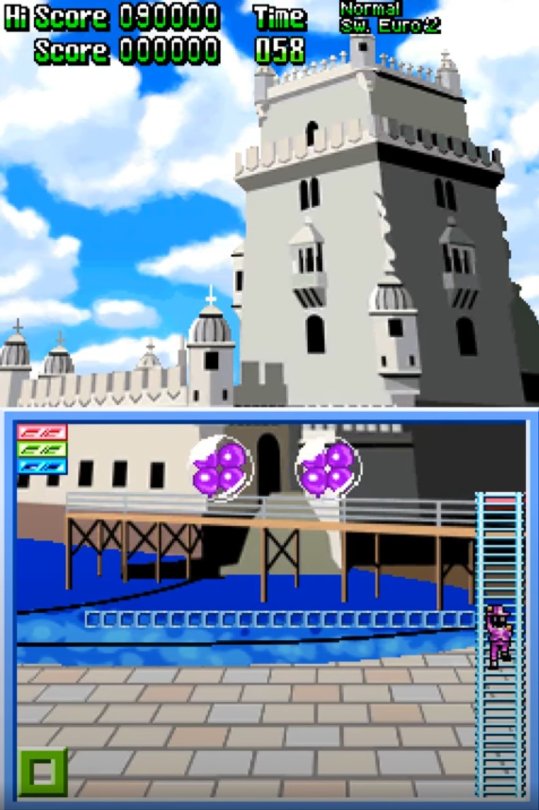

The last Pomping World (a.ka. Buster Bros/Pang) that Mitchell Corporation ever produced before shutting down was the 2010 DS European exclusive Magical Michael. It includes two levels set in Portugal, one in Lisbon by the Belém tower, a nautical landmark, and the other in the Sintra National Palace. Their representation is at once pleasingly stylized and true to life.
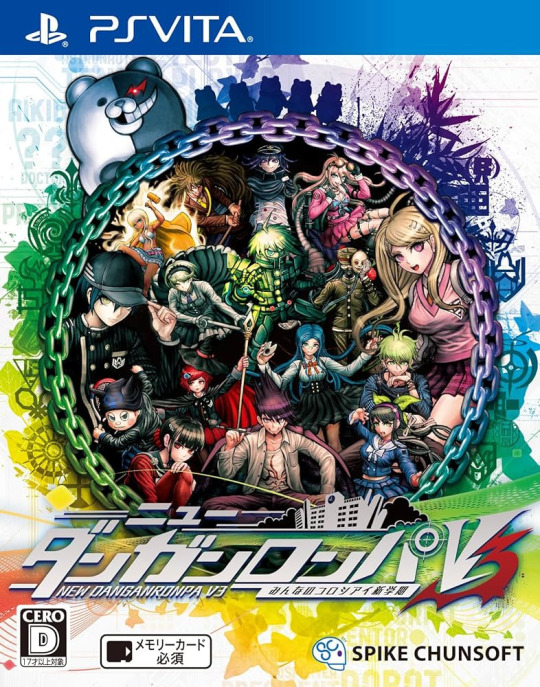
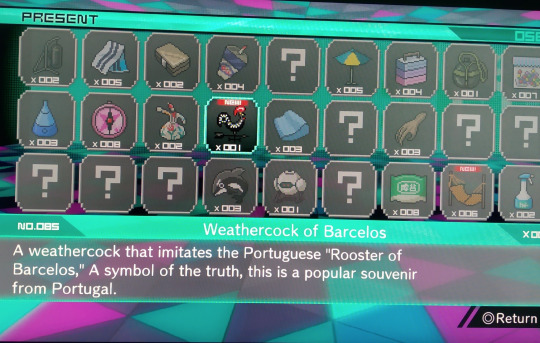
This final reference is found in Spike Chunsoft's third installment of their successful visual novel series, Nyūdanganronpa V3 Minna No Koroshiai Shin Gakki. Among the dozens of MonoMono machine items that can be acquired, one is a weathercock styled after a traditional Portuguese folktale hero, the Galo de Barcelos, meaning the rooster of Barcelos, a town in Northern Portugal.
As per the description, this animal became famous through an age-old tale involving a man wrongly sentenced to death who seconds before his execution remarked he was as certain to be innocent as it was certain that a nearby rooster would sing. Because the bird did crow, much to everyone's amazement, he was exonerated. Thus, the black rooster became a symbol for truth.
I would like to thank @diogojira and @DanielOlimac for their assistance in making this article possible.
#Japanese history#Portugal#culture#tradition#japanese videogames#portuguese references in japanese video games#Uncharted waters#the atlas#neo atlas#maken X#pang#magical michael#grandia II#koei#atlus#game arts#mitchell corporation#spike chunsoft#artdink#lisbon#alfama#Noriyuki Iwadare#kaori kawasume#sintra#book of watermarks
51 notes
·
View notes
Text




Marcus D'Amico in Tales of the City (1993)
521 notes
·
View notes
Text

My latest collage of possibly the most prominent ships within my works based on Street Fighter, Mortal Kombat and Double Dragon.
Ryu x Cammy (American Street Fighter AU)
This pairing largely came from the what-if artwork that Akiman did of Ryu and Cammy's son, but beyond that? I do feel the two have quite a lot in common, especially personality-wise. Plus, Cammy actually admires Ryu in canon.
Guile x Chun-Li (American Street Fighter AU)
The idea of this pairing did technically start with Street Fighter II: The Animated Movie where Guile and Chun-Li teamed up to take down Bison and Shadaloo, but because Guile is more or less the main hero of the American SF AU, it just made sense to pair him with Chun-Li.
Even so, they do have great chemistry together in pretty much the entire franchise.
Liu Kang x Kitana (Main Mortal Kombat timeline)
The pairing that John Tobias intended as far back as the development stages of the first MK game where Kitana was planned to appear as a background character named Kitsune. It eventually was integrated into the canon starting with the 1995 MK movie, and to this day, fans wonder when will they have an offspring.
To me, this is like a mix between a classic fairy tale romance and the traditional tale of star-crossed lovers who may or may not be together in the end. Ultimately, I do want to see them settle together.
Johnny Cage x Sonya Blade (Main Mortal Kombat timeline)
This pairing was technically first hinted at in the MK comics by Malibu, but it first got major focus when it was featured in the 1995 MK movie. Since then, it was hinted at in the 3D games, and it eventually became integrated into canon with the NRS timeline where they ended up giving birth to Cassie Cage.
Despite my ups and downs with the relationship as well as how Johnny was often portrayed in later incarnations (mainly the NRS timeline and the Legends animated films), I do feel it can be done well when given to the right people. It's definitely an "opposites attract" dynamic, for sure.
Ryu x Chun-Li (Japanese Street Fighter AU)
Possibly the most popular SF ship, regardless of it not truly being canon. Many fans, myself included, have always wondered if Ryu and Chun-Li would ever hook up.
Even the SF2 manga from 1993 had it to where Chun-Li had romantic feelings for Ryu, so that might have been one of the seeds that planted the idea of them being a thing in our minds. Since then, Capcom have been teasing fans hard over whether or not they will get together.
Both characters greatly admire each other, and they definitely look cute together. I definitely wouldn't mind it being official either.
Liu Kang x Sonya Blade (Alternate Mortal Kombat timeline)
I would say this is my most prominent ship I have done fan work of, despite it not being the most popular out of these, especially when compared to Liutana and CageBlade.
The pairing was first hinted at in the MK novel by Jeff Rovin, but they never attempted to make it canon, or even drop hints of it in later incarnations. Regardless, I do feel it has great fan art and fanfic potential since the two actually have a lot more in common than you would think.
It genuinely helps that both characters respect and admire each other in canon too. I would also say both this pairing and Ryu x Chun-Li just make sense, considering it's the main heroes and the first ladies of both SF and MK.
Billy Lee x Marian Kelly (Console Double Dragon AU)
While Billy is indeed "player 1" of pretty much every DD game, several of the games also had it to where Billy and Jimmy had to fight for Marian (they were also a trio in the River City Girls games, but I digress).
However, it was the DD games for consoles such as NES that established Billy being Marian's true boyfriend, and so, that is ultimately why it's the case in the "Console" DD AU.
Jimmy Lee x Marian Kelly (Arcade Double Dragon AU)
The official artwork for Double Dragon II: The Revenge has it to where Marian is holding on to Jimmy as he and Billy battle the Shadow Warriors, which did sort of imply that Jimmy was Marian's boyfriend.
Since the arcade games never truly explored lore details, I decided to fill in the blanks as well as take some liberties by making Jimmy x Marian a thing. It also helps that Jimmy is the more mature and stoic Lee brother in this AU while Billy fills such a role in the "Console" AU.
There are some other pairings I left out, such as Ken x Cammy, Kung Lao x Li Mei, and Kitana with both Johnny Cage and Kuai Liang (again, as both Scorpion and Sub-Zero), but I would say these are the most prominent ones.
#mortal kombat#street fighter#double dragon#liu kang#sonya blade#kitana#johnny cage#ryu#chun li#guile#cammy#shipping#alternate universe#ideas#my commentary#liutana#cageblade#kangblade
10 notes
·
View notes